Editor’s note: This text-based course is an edited transcript of the webinar, Managing Time for Directors, presented by Lauren Ellis, MA.
Learning Outcomes
After this course, participants will be able to:
- Identify key priorities and time expenditures within their role.
- Describe how to create short and long-term schedules and scope and sequences outlining their responsibilities within designated timelines.
- Explain how to communicate about and hold boundaries regarding their schedules.
Introduction
We hear, read about, listen to, and think about time all of the time. We are either wasting it or wishing it would go by faster or slower. We all have 24 hours in a day, seven days in a week, and 52 weeks in a year. By gaining mastery of my schedule and my time, I was able to be more productive and less stressed. My scheduling and timing is not always perfect. However, since I have a strong plan in place, I am able to quickly readjust and keep moving forward. We are going to look at how you are spending the time that you have. Is it effective? Is it efficient? Should you be spending it in other ways? Note that you have many handouts in this course, including blank forms I will talk about and completed ones as examples.
Our Agenda
Today's agenda is going to be a multi-step process in order to create a daily, weekly, monthly, and yearly schedule. This can help you be effective and efficient in your role. From my experience, schools and education entities are cyclical. Assessments, celebrations, special events, units of study, and other examples often happen around the same time every year. If we can forecast for them, we can plan for them.
- Understanding Your Daily and Weekly Time Landscape
- Creating a Daily and Weekly Schedule
- Practicing with Your Product and Accounting for the Unexpected
- Creating a Structure for Daily and Weekly Self-Check-Ins
- Applying Your Practice to a Long-Term Scope and Sequence
- Understanding Your Monthly and Yearly Time Landscape
- Creating a Monthly and Yearly Schedule
- Planning for Communication with Stakeholders
The first thing we are going to do is look at how to understand daily and weekly time landscapes. If I were to ask you right now how you want to spend your week, you probably have an idea in your head. However, we want to be specific and make sure your plans will happen in real life. From that, we are going to create a daily and weekly schedule. You are then going to practice with the schedule that you made. Make sure you account for the unexpected.
Over the course of two weeks, test it out and think about what worked and what did not work. What did you spend more time on? What did you spend too little time on? That is going to create structure for yourself regarding daily and weekly self-checking. You are going to take the knowledge that you gained from the short-term planning and apply it to a long-term sequence. That is going to create a monthly and yearly time landscape.
All of this would be remiss if we did not talk about stakeholders. How do we share the prioritization that you have created around your time and your schedule? How do we help communicate with stakeholders about how to hold time sacred and what your priorities are?
I am going to tell you how to create both a short- and long-term scope and sequence. That being said, I highly recommend that you take notes and use the templates provided in order to guide your practice. You can print out these templates and complete a hand-written version. This is because there will be many times that you have to look at and reference a few of these pages at the same time. However, do whatever is fluent for you.
Words You Will Hear
I will be using a few terms throughout this course. Here are some definitions that will be important to remember:
- Effective: High positive impact
- Efficient: Effectively completed within the shortest amount of time
- Task-List/Tasks: A list of to-do items, meetings, etc. that need to take place in order to be effective
- Schedule: Allotted times for task list
- Time Audit: An assessment of how and where time is spent
- Scope-and-Sequence: A forecast of events or tasks to be completed over a long period of time
In terms of being effective, you can sit in your office and spend 20 minutes online shopping, but that does not have a positive impact on your educational institution. If you spend your time effectively at work, you will have more time for your personal priorities.
For efficiency, this means work is being effectively completed within the shortest amount of time. It is important to know that if your end product is sloppy or half-done, it is not going to be effective, even if it is efficient. Sometimes, efficiency takes time. For example, I remember waiting tables when I was in college and I would forget things all the time. It took a few weeks for me to get the rhythm of waiting tables to make sure that all of my customers were happy. Give yourself time. With practice, you become more efficient and more effective.
Task lists are lists of to-do items or meetings that need to take place in order to be effective. Your schedule is an allotted space for your task list. Whether it is meetings, sending emails, or completing a budget, we will talk about how to schedule it in.
Just like your bank account, time audits show where your priorities are. Your calendar and schedule show where your time priorities are. Throughout this process, I am going to ask you to be ruthlessly honest with yourself. For example, if you say a task took 15 minutes to complete but you spent 8 of those minutes checking Facebook, you are not being honest.
Regarding scope-and-sequence, we are going to look at days, weeks, and months, as well as the entire year together. Being able to see the long-term view will help you with planning in the immediate.
Special Note
You most likely know folks who look busy because they think it makes them look important. However, we all know the truth. They take double the time and do half the work, and their work is not even that great. Instead of being like those people, let us spend the correct amount of time on tasks and efficiency for our educational institutions. A well-known adage in my school was GSD, which stands for “get stuff done.”
Understanding Your Daily and Weekly Time Landscape
Let us think about what fills your weeks. Take a minute and think about what you do during the week. If you are like me, you have probably come up with a list like this in Figure 1.
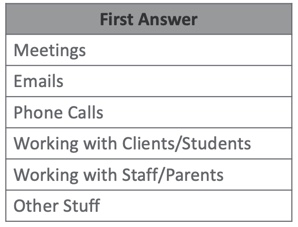
Figure 1. What fills your weeks.
My work week is filled with meetings, emails, phone calls, working with clients, working with students, working with staff, and so on. However, that is not completely what your week looks like. When you say the word “meeting,” what does it really look like? For example, who are you meeting with? Are they at your education institution or are they off-campus? Are you leading the meeting? Ask yourself these questions for each of the items on this list.
I bet you find that your list is growing the more that you think about it. In fact, I think it is probably looking like the chart in figure 2. This is all just the tip of the iceberg. For example, if you are in charge of material procurement, that could include running out to the store and getting pencils because you do not have enough. This includes travel time if you have to travel to see students or clients. Before you create a strong time management tool, you need to do an honest evaluation of the perception of how you think you spend your time versus how you actually spend your time.
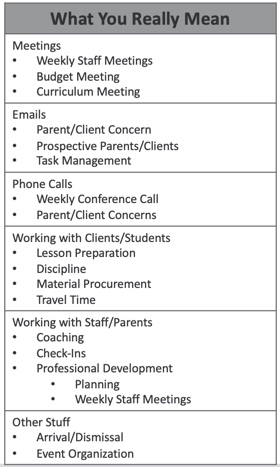
Figure 2. What you really mean.
In order to understand this, I want you to understand your daily and weekly time landscape. One of the resources that has been provided for you is a blank template called Understanding Your Daily and Weekly Time Landscape. Figure 3 shows an example of a blank template that you can print out and use to collect your thoughts. Do not worry about the right-hand column right now. Go with your first answer in the left column. My list included meetings, emails, phone calls, etc. as you saw in Figure 1. What would your list include? Take a minute to think about that and fill out the left column.
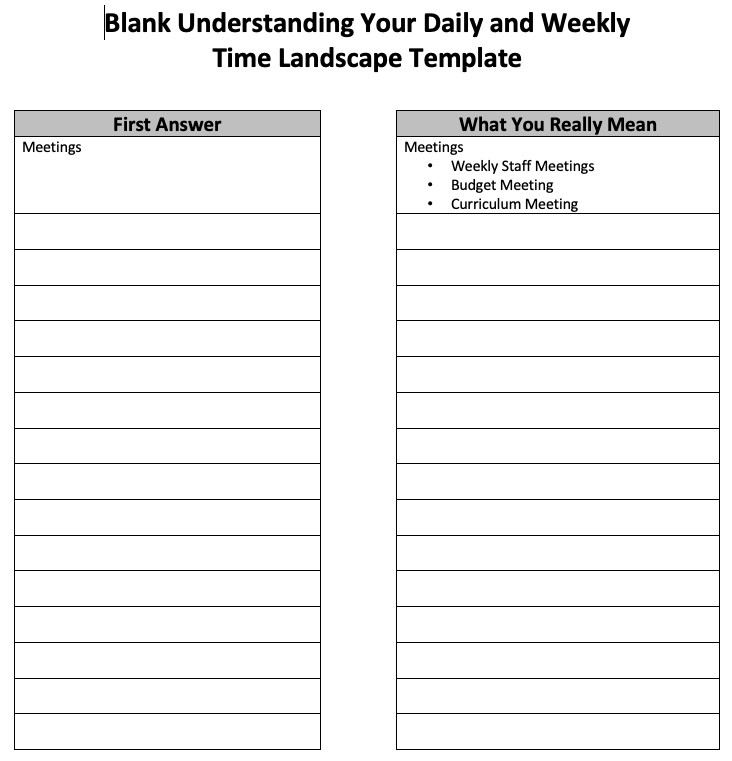
Figure 3. Blank understanding your daily and weekly time landscape template.
Now take a minute and transfer the headings from figure 2 in the first answer column over to the column called “What You Really Mean.” Write down what really takes up your time under the right-hand column. What meetings do you have? What emails do you send? I provided an example for you. You do not have to catch every single detail, but you should have a good list.
General Time Audit
Next, you are going to create a general time audit, which is shown in Figure 4.

Figure 4. Blank general time audit.
You are going to take the list that you created and write down when you perform the tasks. For example, if there is a certain task that takes place every Monday, write it in the Monday column. If there is a task that happens every day, write it out every day. If there is a task that is important but does not have a set time or day associated with it, put it under the priorities heading. Figure 5 shows what that could look like.
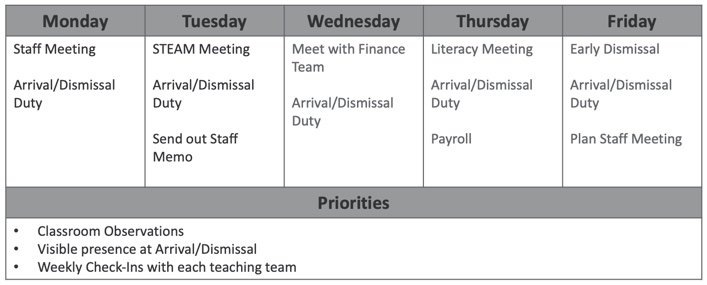
Figure 5. Sample general time audit.
As you can see in Figure 5, on Monday, I have a staff meeting. This occurs every Monday without fail, from 4:30 to 5:30. Therefore, it was a prioritized time. Another priority is arrival and dismissal duty every day. This entailed being at the front doors to greet parents and students and make sure that we are available for any questions, comments, concerns, or celebrations that came up. I knew that between 7:45 a.m. and 8:15 a.m. and 4:00 p.m. and 4:30 p.m. every day, I could not hold any other meetings. Since that happened on a daily basis, there were other things that I could move around, such as classroom observations and weekly check-ins with the teaching team. They did not have a set day, but I knew I wanted them to happen on a weekly basis.
Take the handout you completed called Blank Understanding Your Daily and Weekly Time Landscape and put events into the days where they belong in the handout called Blank General Time Audit Template. Looking at the Blank General Time Audit, fill it out without necessarily looking at your calendar or your schedule that you already have. I want you to do this without looking at those resources because you have a better feeling about what should happen and where, when, and how.
Specific Time Audit
Once you have your general time audit, lay it aside. We will come back to it. Now, you are going to actually create a time audit. A time audit is an assessment of how and where your time is spent. We want to see if what is in your head matches up with what is actually happening. In this time audit that you are going to create, you are going to write the time that you spend on every single task for one full week. You may be thinking, "I do not have time for that." I argue that you do not have the time to not do it. Sometimes we have to go slow to go fast. It might seem cumbersome and time-intensive, but it is important. Figure 6 shows a blank, specific time audit template.

Figure 6. Blank specific time audit template.
Looking at this template, you are probably thinking, "My day starts before 7:45 a.m. and ends after 6:00 p.m." I understand that there are all sorts of things that have demands on your time. However, this is specific to work. For example, I broke it up into 15-minute increments according to the work hours that I have. However, you can edit this in a way that works better for you.
What you are going to do is fill out this template with everything you do every 15 minutes. Let me be clear: not every box needs to have something in it. In fact, the blank spaces are going to be helpful to us. You might be thinking, "What if I send an email and it only takes 10 minutes? What do I do with the other five minutes?" Put emails into that 15-minute box. If you complete two tasks in 15 minutes, put both tasks into that box. If the task takes longer than 15 minutes, block off the whole amount of time it took. Personally, I found that using colored pens helped me. This is because it allowed me to designate which boxes were where and which tasks ended when. Figure 7 shows an example of what your template should look like at the end of the week.
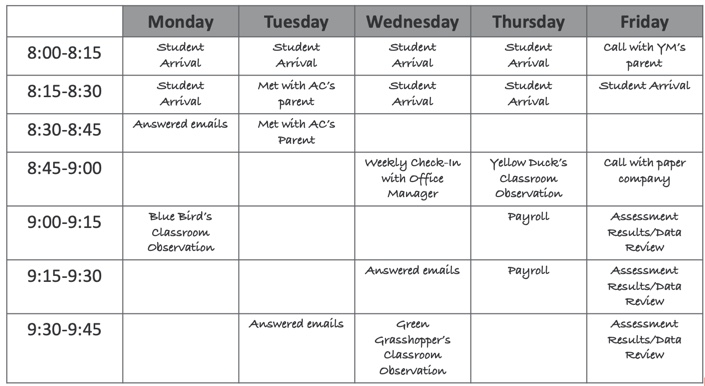
Figure 7. Completed specific time audit.
Looking at this example in Figure 7, you may notice that you went to arrival every single day except for Friday. This is because you had to talk to a student's parents. Also, it looks like Monday was fairly quiet, but Friday got busy for you. You achieved some priorities as well. For example, you observed in different classrooms and checked in with your office manager.
Reviewing Your Time Audit
Next, you are going to review your time audits. Sit down with your General and Specific Time Audits. Here are some questions to consider during this project:
- What day(s) were busier or slower than others? Why?
- When were the open times in your week?
- What themes did you see emerge? (For example, around 11:00 am every day a particular need arose.)
- What tasks took longer/shorter than expected?
- Did you accomplish everything from your General Time Audit within your Specific Time Audit?
- Were there additional things on your Specific Time Audit that were not on your General Time Audit?
- Who do you need to set recurring meeting times with? What meetings need to be scheduled as reoccurring?
This is not an exhaustive list, but at the minimum, I think these are the questions that you need to ask yourself.
Take out your general time audit, where you put all the topics into the individual days with priorities at the bottom. Lay it next to your specific time audit. Did you cross everything off of that general time audit list? Did you actually do those things that you had brainstormed ahead of time? Did some of them get left off? Were there additional things on your specific time audit that were not on your general time audit? Were there things that you did not account for? Who do you need to set reoccurring meeting times with? What meetings need to be scheduled as reoccurring?
One of the things that I did not do my first year in school leadership was meet with my office manager on a regular basis. I felt like she knew what to do and where to go and who to talk to. She was great at her job. But the problem was, I did not know what she was doing. It was often that we would be doing double the work or not connect on a certain topic. We then set up a regular meeting with one another. That gave us the opportunity to touch base every week and talk about what situations had come up, how to handle them, what communication needed to go out to staff, and so on. Since we got into a routine, we ended up having a standing agenda that we followed every week. This created predictability for both of us and decreased the number of interruptions that we provided for each other. Instead, the things that were not immediate we saved for this meeting time.
Take a look at Figure 8, which has an example of comparing your two audits.
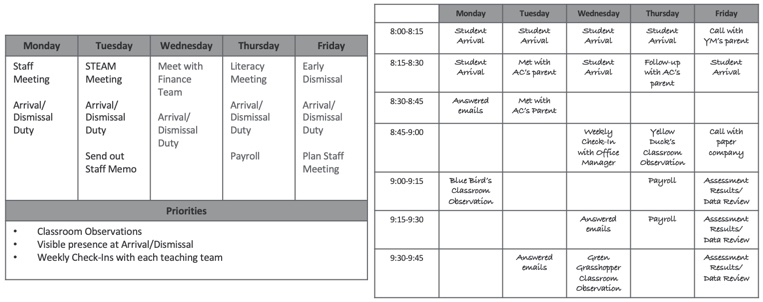
Figure 8. Comparison of two time audits.
As you look at the examples in figure 8 and in your own time audits, ask yourself the following questions.
- What trends do you see?
- What themes emerge?
- Where did I and did I not prioritize?
Creating a Daily and Weekly Schedule
After you go through the process of looking at your two time audits, you are going to create a daily and weekly schedule. Figure 9 shows a blank weekly schedule template.

Figure 9. Blank weekly schedule template.
You are going to create your weekly schedule to reflect the priorities that were on your general and specific time audits. If there is something that happens every day or on a specific day, put that in. Do not worry about your other priorities yet.
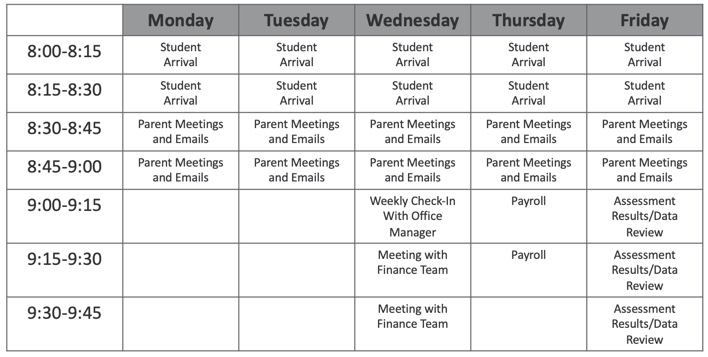
Figure 10. Sample daily and weekly schedule.
As you can see in figure 10, student arrival was my priority. It was non-negotiable in my schedule, so I put that in first. Also, I knew it was important to be available for parent meetings, so I put in parent meetings immediately following arrival. If a parent did not request a meeting one day, I used that time to send emails or do other small administrative tasks.
Have you heard the analogy of how to fill a jar? You put big rocks in first, smaller pebbles, sand, then water. If you do it the other way around, your jar will overflow. Focus on the priorities first (the big rocks), then the smaller items afterward. Remember that those smaller events are not less important. They just do not happen on a regular basis. For example, that weekly check-in with my office manager was important but did not happen every day, so I put that in as a priority. Payroll is important as well, so I put that in as a priority.
In the example in figure 10, there are still blank spaces in the calendar. This is a good thing because you do not want to completely fill up your schedule. If you do, you are not going to be able to adjust or pivot when needs arise. This is especially important for a school leader or a director.

Figure 11. Sample completed daily and weekly schedule.
Figure 11 is an example of what a daily and weekly schedule could look like. The items in black were my nonnegotiables. They were not going to change as long as I could be in control of my schedule. Things can happen that require us to adjust, but those items in black happened at those times every single week. Additionally, my predictability allows my staff to rely on me. They knew that payroll was going to happen on a regular basis. They knew when I was available to talk versus when my door was closed and doing other work.
The items in red are reoccurring priorities. They were things that I needed to do every single week. The items in blue are still priorities, but they did not have to happen on a regular basis. For example, I knew that classroom observations were a priority. Putting those events into the blanks spaces I had was the first thing to happen. I also knew I needed time to prepare for that meeting with the teacher. However, talking to my special events coordinator was a one-off situation. I plugged that in later because it was a lesser priority.
My goal for you is to create a daily and weekly schedule where those black items stay black. You can put in the red next, and the blue items afterward. This will take some practice and you will need to do this weekly, as some of your priorities and tasks may change from week to week.
Practicing With Your Product and Accounting for the Unexpected
You are going to create your daily and weekly schedule putting in all of those important big rock priority items, the items that do not change first. Then you are going to put in your priority items that can be moved around but still need to happen each week. Then add the priority items that are one-offs. You will enter black, red, then blue items into your chart. You are going to practice with this for about two weeks. You will want to look at your schedule and think, "What did I not account for? "Where was I spending too much or too little time?"
Do not forget to have this in paper form so you can write down what did or did not happen, as well as notes in the blank spaces. The more data you take, the better you are going to be able to analyze it later and see trends. We want to account for the unexpected. What came up? We also want to think about what is coming up in the next week or month.
Also, consider if you have work times put into your schedule. Work time every week was nonnegotiable for my administration team and me. This is because it was a time that we were able to get work done without any distractions. For example, I would go into a conference room and get work done for two hours. While I was GSDing, my two vice principals checked in on teachers, helped students, and so on. They knew to only interrupt me if it was an emergency. It is okay to block off time for yourself and finish what needs to be done. No one else in your organization or building has your job. There are certain things that only you can do and you need time to do them. Having a time that is effective and efficient is important.
Applying Your Practice to a Long-Term Scope and Sequence
Once you have practiced your schedule for at least two weeks and adjusted any mishaps, you are going to keep doing it. Truth be told, years later I still adjust my schedule. This is because the needs of my school continue to change. Generally speaking, those items that were in black have not changed. If you master the short-term, you can also master the long-term. If you planned for the expected, you can have a plan for the unexpected.
We are going to look at practicing this on a long-term scope and sequence. This is important because sometimes there are seasonal versus re-occurring tasks/events. You are in charge of being strategic in leading, resourcing, and communicating with all stakeholders: parents, teachers, community members, and students. I often liken it to being the mayor of a small town. I was the most popular person in the building. Your daily and weekly scheduling, as well as your monthly and yearly scheduling, should not be done in isolation. You work on a team and there are many moving parts and community members. You need to look at who you interact with on a daily, weekly, monthly, and yearly basis.
Monthly “Buckets”
Now we are going to talk about monthly buckets. Figure 12 shows an example of what happened at our school for six months. In July, our teachers returned because we had an extended school year, but there were no major events. In August, we had our “Welcome Back Barbecue.” By November, we were holding literacy nights or having report card conferences. Figure 12 is an example of monthly “buckets.”
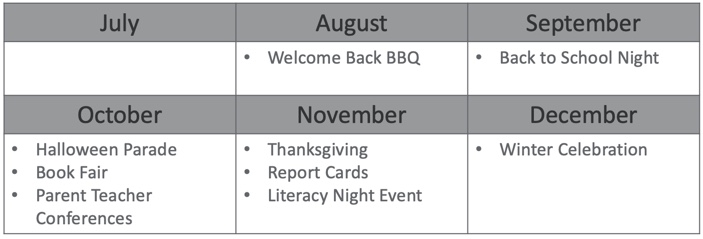
Figure 12. Completed monthly buckets form.
Looking at the handout titled Blank Monthly Buckets Template, you can see there are 12 months written out. You are going to write special events, celebrations, assessments, and anything else that happens in each of these months. You might have a 12-month schedule, a 10-month schedule, or a 6-month schedule. Only use the months that are applicable to your work and put down the events in their specific months.
Do not worry about planning yet. For example, if you are having a Halloween parade in October, do not think about ordering decorations in September. You do not have to think about that yet. Just like your general time audit, you are first going to capture your thoughts. Remember that schools are cyclical. If you are like me, you have been in school for at least 30 years and you know when certain events happen. For example, when I first started at our school we did not have monthly literacy nights. However, it was a priority that I had.
Once you have an idea of what happens in each bucket, you are going to start planning backwards. For example, start by focusing on the month of October. There is a Halloween parade, a book fair, and parent-teacher conferences. If I look at the other months, I know that there are other things coming up and I am going to have to backwards plan. As you can see in figure 13, I started to write down in red the things that I would need to do to make sure that each of those items happens in a timely way. You most likely know this already, but I find that the more that I write things down and have them preplanned, the less I have to rely on my memory. Personally, my mind gets filled quickly. I hold a lot of details in my mind, so the most obvious things would be the first to fall off my radar. Let's not have that happen.
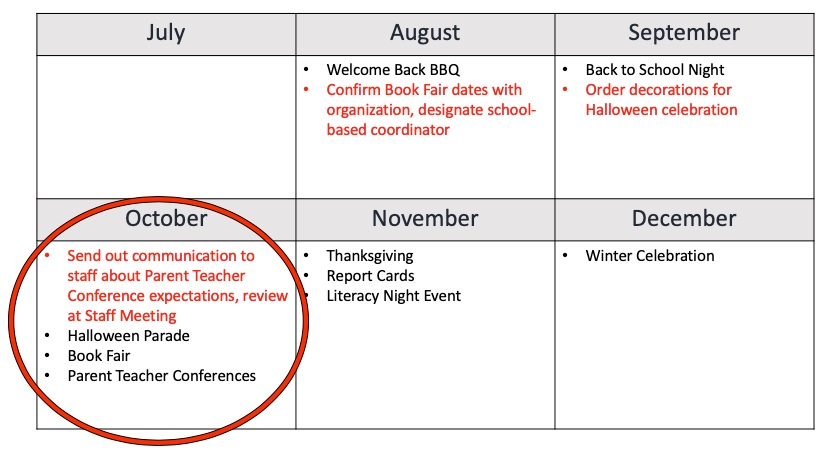
Figure 13. Completed monthly buckets form with more details.
For the book fair in October, I have to start communicating with people about potential dates. This is backwards planning. Therefore, August will have a bullet point that will remind me of that. In September, I order the Halloween celebration materials because I want them to be there for October. Also, our parent-teacher conferences happen in the last week of October, so I communicate with the staff about it during the first week of October. This is all to make sure these events go smoothly.
After this, you should see your monthly buckets start to shift out. Figure 14 is an example of how to complete your monthly buckets. This example is my own monthly buckets file. I took out specific names of assessments or programs so you would not get caught up in them. Some of the events are also specific to my school. This example is my own monthly buckets file. I took out specific names of assessments or programs so you would not get caught up in them. Some of the events are also specific to my school.
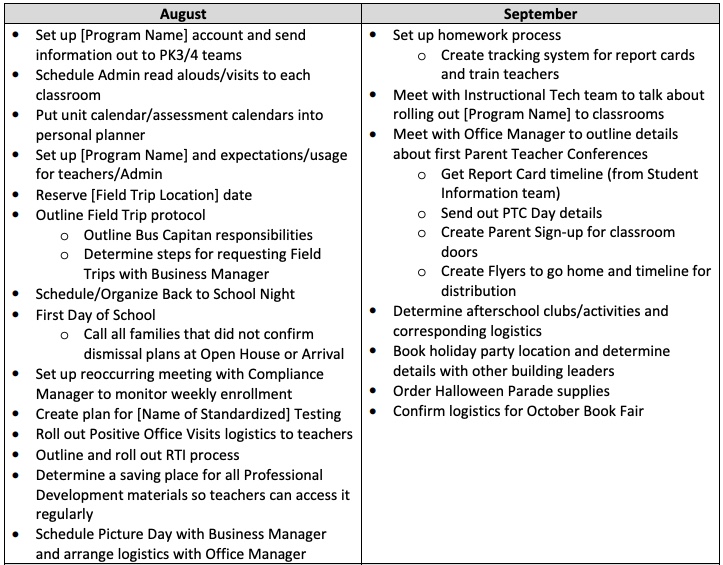
Figure 14. Sample monthly buckets.
Looking at the example in Figure 14, you can see that August and September have a lot of events. On the other hand, October and November are much shorter. This is because a lot of what was happening in October and November needed to have planning start in August and September. Although August and September are busy with the beginning of the school year, they do not have a lot of events. Instead, I use that time to get pre-planning done. In October and November, teachers are getting more tired and we have more events taking place. Therefore, planning and logistics do not have the same priority as they did in August and September.
If you have an administration team that you work with, they are going to benefit from seeing your buckets as well. Remember when I talked about not doing this work in isolation? This is a great task to have multiple voices contribute to because they are going to help you remember details or think about timing in ways that you may not have thought about before. In this case, more minds are a good thing.
Once you have your monthly buckets written out, you are going to not only put in events, but you are also going to put in assessments or units of study as well. This is important because if an assessment is being given to your whole school or specific grade level or student, your staff needs to be trained on how to give the assessment and how to use the assessment data at a later point. If there is a unit of study, you may need to procure materials or come up with lesson plans. Having those assessments and units of study in your monthly buckets is important in terms of backwards planning. The more you can forecast, the better you are going to be able to plan in the short-term.
Creating a Monthly and Yearly Schedule
Once you finish up your monthly buckets, you are going to create a monthly and yearly schedule. For example, let us start with the month of October, shown in Figure 15.
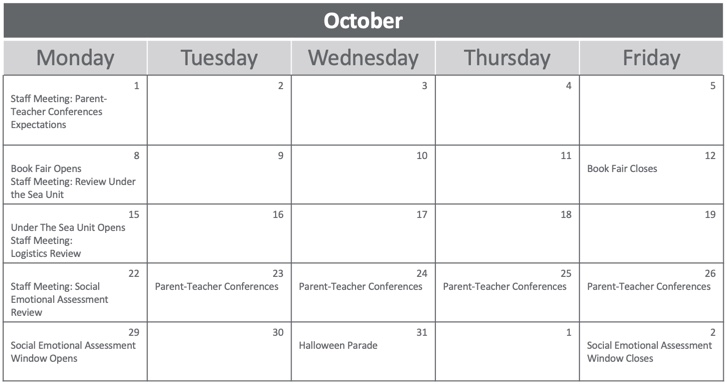
Figure 15. Sample monthly calendar.
The Halloween Parade is on the 31st. I have added in when a social-emotional assessment window opens and closes. There are parent-teacher conferences at the end of the month that we need to think about. On October 1st, there was a staff meeting in which conference expectations were talked about because their training had to happen at the beginning of the month. The book fair opened on the 8th, but we were prepared because we had talked through the logistics in August. Monthly buckets allow you to create a calendar for yourself. Take a look at Figure 16, which is a sample monthly calendar from my school.
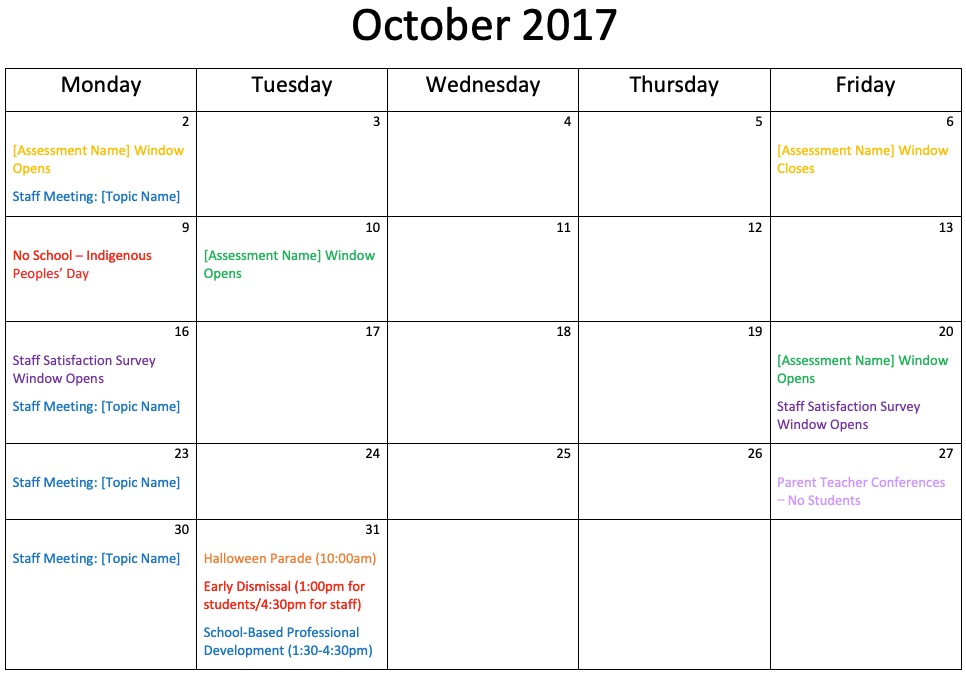
Figure 16. Sample monthly calendar from actual child care center.
This is a real calendar from October 2017. You can see that there were times when assessment windows opened or closed. There was no school or early dismissals on other days. I had our staff meeting written in for every Monday. This schedule provided a large view for me. I was able to see what was taking place over the course of the entire month.
How does this relate to our daily or weekly schedule? If I can see a full month ahead, then I can plan for my week, followed by my day. The items in blue are the ones that change from day-to-day or week-to-week. An example of this would be our assessments opening or closing. The staff meeting would be a black item. It happens every week, but the topic changes, and I can adjust that according to what is coming up.
Your monthly and yearly schedule will help you be a clear communicator to not only your staff but to parents as well. Parents like to know what is happening at the school, preferably before the night of the event. How many times have you had to do a science project the night before because you swear the school never told you? Calendars, newsletters, flyers, or Instagram posts are a great way to communicate with parents regularly about upcoming events. Parents do not have to know about every staff meeting. However, it may be helpful for them to know which units or parades are coming up.
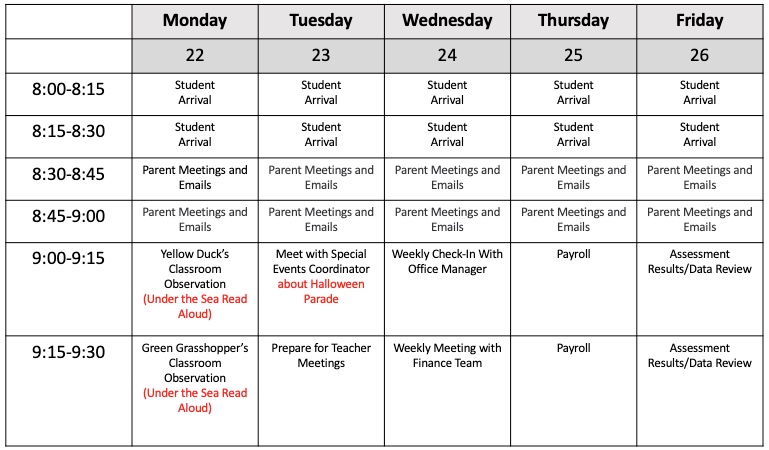
Figure 17. Tying your monthly and yearly schedule to your daily and weekly schedule.
Figure 17 represents how your monthly and yearly schedule leads back to your daily and weekly schedule. The two schedules are connected because we are then able to plug in specific events. Student arrival, parent meetings, payroll, office manager check-in, finance team meeting, and assessment results and review all stayed the same. However, events like the Yellow Duck's Classroom Observation and the Green Grasshopper’s Classroom Observation used to be in red. Those were things that I moved around. I now know that I am really looking for the Under the Sea read-aloud. Another example is the meeting with the special events coordinator. It used to be in blue, but now I know that we are going to be talking about the Halloween parade that is happening in a week.
Therefore, having a calendar that focuses on the months allows me to get more specific about my week. It also allows me to use my time effectively and efficiently.
Daily and Weekly Self-Check-Ins
Here are some points to remember that will help your daily and weekly self-check-ins:
- Each week, set aside 30-45 minutes to set-up your schedule for the following week.
- Some questions to consider:
- Are there any days with a shortened schedule (half-days, off-campus meetings or professional development, etc.) in the next week?
- Were there any priority items that were not upheld this week that need to be an extra priority in the next week?
- What upcoming events or task-list items do you anticipate in the next two weeks/two months that you need to begin planning for now?
Communication with Stakeholders - Setting and Holding Boundaries
Your schedule is useful, but it does not matter if you are the only one who has it. You have to be able to communicate, as well as set and hold boundaries. Why is this important? You are the only person in the building with your job and you set the tone for priorities in your school. If literacy is a priority in your school, no one is going to make it a priority if you do not model that in how time and resources are spent.
Your work impacts every other person in the building. They are looking to you on how to act, communicate, and teach. Your calendar and how you spend your time are important. You do this by communicating expectations ahead of time. This means that you suddenly implementing a schedule is not going to change the world. You will have to tell people, "We are going to have this meeting. We will start right on time, and this is when the meeting will end."
You will need to follow through and hold those events as sacred. You are going to have to hold yourself to a tight schedule. You can no longer run two or three minutes late. I understand that emergencies come up. However, if you have planned ahead, those emergencies should be far and few between. We do not want it to turn into a “boy-who-cried-wolf” situation.
You will also want to offer alternate solutions. For example, there may be a parent who can only meet with you during student arrival. Offer to call them at work or during their lunch hour. Find a time that works for both of your schedules. You will also want to give your reasoning, such as saying, "I value your input,” or, "I want to hear what you have to say." People will respond to and appreciate that.
Your schedule is important, and taking control of it is your responsibility. If you do not hold clear expectations and boundaries, none of them will be held. What you model is how your school will perform. Therefore, take the time to go through this process. Try your schedule out for a few weeks and ask yourself questions about it. What worked? What did not work? What needed to be moved around? What took too long or too short?
Once you have a handle on your calendar, sit down with the people in your work environment and think about what happens on a monthly basis. How can we start backwards planning? How can we plan ahead on different events? This will eventually form your entire school year. Even though it will take some time, you will soon find that you are prepared and being both effective and efficient in your day. You also will see a positive impact on the community around you.
Summary
I am passionate about time and task management. I have seen it transform my own life. My first few years as a school leader were frazzled and I would think to myself, "How am I going to do this for the next 20 or 30 years?" It was my dream job, but I suddenly felt unequipped. This time management process was difficult, as it took being honest with myself about setting boundaries and following through with my goals. After the process, I now have time in my evenings. I go to sleep at a reasonable hour, have time to exercise, and I can see friends and family. Effectively and efficiently using work time will help you have a personal life and a balance that you are looking for. I cannot promise that it will always be perfect, but it can be adjusted.
References
Citation
Ellis, L. (2019). Managing time for directors. Continued.com - Early Childhood Education, Article 23610. Available at www.continued.com/early-childhood-education
